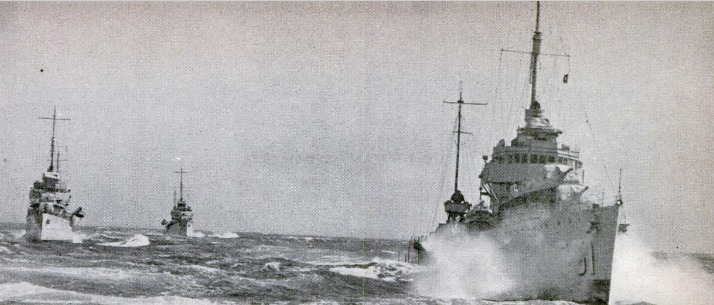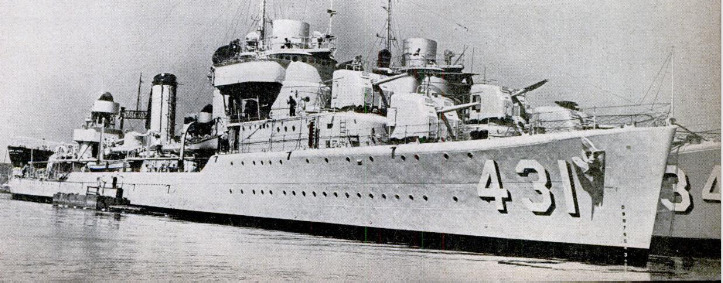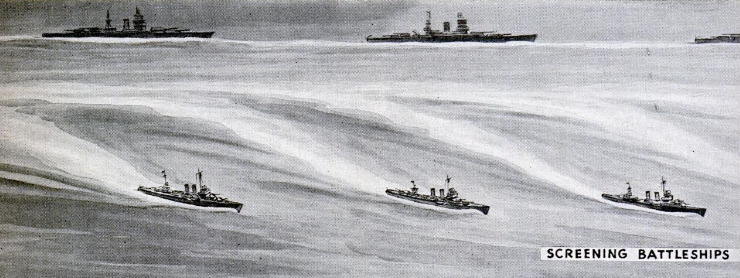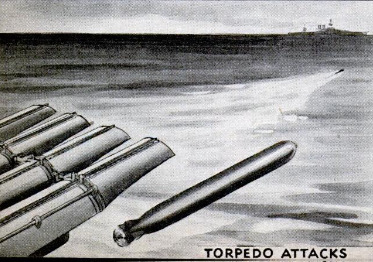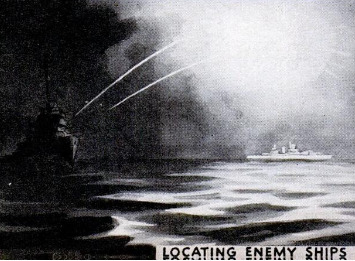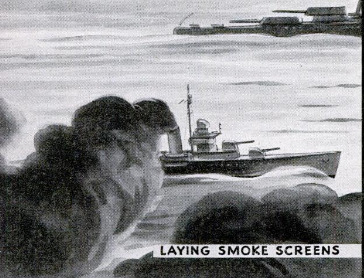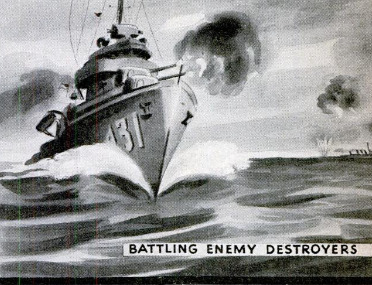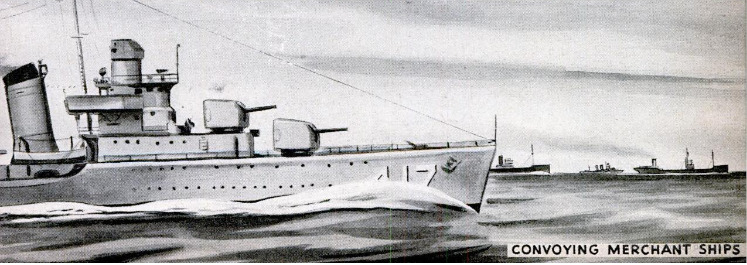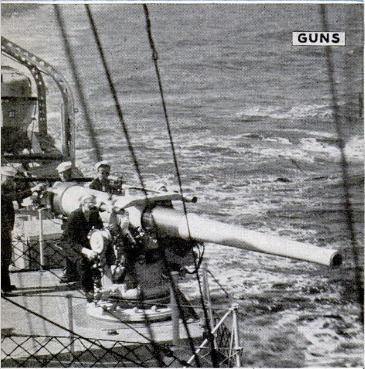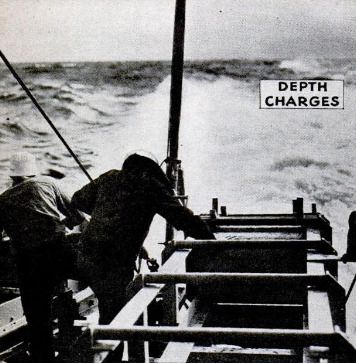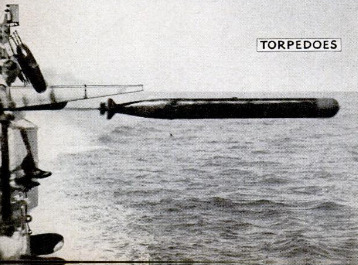-
Title (Dublin Core)
-
Destroyer heating power
-
Article Title and/or Image Caption (Dublin Core)
-
Title: Destroyer heating power
-
extracted text (Extract Text)
-
DESTROYERS of a new American type,
classed as high-speed troop transports,
have joined the fleet. In conjunction with
landing maneuvers practiced by TU. S.
Marines in Caribbean waters, this winter,
they are believed to have solved the prob-
lem of quelling a fifth-column uprising in
Latin America.’
In response to an appeal for aid, the ves-
sels will race to a trouble spot, carrying
picked, heavily armed Marine detachments.
If hostile guns bar entrance to a harbor,
the men will be prepared to ferry them-
selves ashore on any convenient beach, with
armed landing boats of special design.
Their duty will be to suppress the trouble
makers, or hold them at bay until slower
transport vessels arrive with reinforcements.
‘War events abroad have proved the ad-
vantage of getting to places first, even if
it is with only a small body of crack troops.
Reconditioned destroyers in Atlantic
service have been transformed into the first
of the high-speed transports, by removing
the deck-mounted torpedo tubes—super-
fluous except in naval battles—and rear-
ranging eating and sleeping quarters to ac-
commodate the extra men aboard. By ex-
perimenting with these converted ships, the
Navy is standardizing their design, saving
time and avoiding possibly costly errors in
building an untried type.
Likewise, old but serviceable destroyers
have been chosen to test other naval inno-
vations. Several are being converted into
our first antiaircraft ships. Like a number
of cruisers of the British fleet, which intro-
duced the type, they will become floating
nests of high-angle artillery, and will have
the sole mission of shooting down air raid-
ers. They are expected to mount three-inch
guns for bringing down high flyers, and
1.1-inch rapid-fire guns of a recent design to
deal with dive bombers. Besides serving with
the battle fleet, such vessels would guard
convoys of merchantmen against the new
menace of air bombing.
More than a dozen converted destroyers
will serve as mobile bases for the Navy's
giant patrol-bombing planes. Soon after
this country acquired the right to establish
a naval base on the British-owned island of
Bermuda, for example, the United States
destroyer George E. Badger dropped anchor
near Hamilton and began operating as a
tender for the American flying boats. The
incident illustrates how the whole chain of
Atlantic outposts gained in our destroyers-
for-bases deal with Britain can be used to
our immediate advantage, pending com-
pletion of more permanent facilities.
These new duties supplement the varied
ones that make a destroyer the most ver-
satile of major fighting craft. In a naval
battle, destroyers conduct torpedo attacks!
upon enemy battleships; they “screen” their
own against submarines, with depth charges,
and against enemy destroyers, with shells.
Their double-purpose guns can be elevated:
to extreme angles for use against aircraft.
To hide offensive or defensive maneuvers,
their funnels belch smoke screens. At night,
their star shells illuminate enemy targets.
In addition, destroyers serve as fast mine-
layers and minesweepers; escorts for con-
voys of cargo ships; submarine chasers on
the high seas; and, within the limits of their;
cruising radius, commerce raiders. Destroy-
er crews of our own Neutrality Patrol,’
while under orders only to “observe and
report” whatever goes on in American
waters, have been obtaining first-class
training for reconnaissance in war. Among
other things, they have followed. and ascer-
tained the nationality of ships which would
not signal their identity.
Only lightly armored, a destroyer can be
sunk, according to the U. S. Coast Artillery,
with an average of half a dozen six-inch
shells that pierce its sides. The British de-
stroyer Gurkha, attacked early in the cur-
rent war by German aircraft, was the first
modern warship of its size to be sent to the
bottom by air bombing.
Nevertheless, experts rate destroyers as
second only to battleships in deciding the
outcome of a sea engagement. Ton for ton,
they are the most powerfully armed of any
type of man-o’-war. To a modern fleet, they
are indispensable.
By recently announcing the addition of
. 40 more destroyers to its already gigantic
building program, the U. S. Navy empha-
sizes the value of these swift, hard-hitting
craft. And a $1,750,000 seagoing dry dock,
to follow the fleet wherever it steams, is
its answer to the question of what to do
with destroyers seriously damaged in ac-
tion, or in need of complete overhaul, far
from established navy yards. The mobile
base will service them at any lonely outpost
—perhaps in the South Seas, in Alaska, or
at one of the “stepping-stone” islands be-
tween Hawaii and the Orient.
A smaller floating dock of 393-foot
length, the ARD-1 was launched and com-
missioned in 1934 to try out the idea. It
has been stationed at San Diego, Calif.
According to Rear Admiral Ben Moreell,
head of the Navy's Bureau of Yards and
Docks, “That was the first floating dry dock
of this type that we ever built. One of those
1,500-ton destroyers is the largest it will
take, and even with those you can’t pull a
shaft in it. It will not take a destroyer
leader or a large-sized submarine. It was an
experimental structure, and it has been so
successful and the fleet is so pleased with
it that we want to go ahead and build
this larger dry dock. It will take the largest
new-type submarine or destroyer leader,
and you can pull a shaft on that destroyer
leader.” Impressed by the Admirals words,
Congress voted funds for the novel dry
dock last June.
According to latest figures, this country
leads the world in the number of destroyers
built and building, with a total of 365. Next
in order come the British Empire, 240; Ja-
pan, 146; Italy, 132; Russia, 83; France, 80;
Germany, 47. Because of wartime secrecy,
some of these totals necessarily are esti-
mates, based on the best unofficial infor-
mation.
As for destroyers completed at this writ-
ing, the British Empire trades places with
us at the head of the list, and the other
powers follow us in the same order. With
135 destroyers afloat, Japan comes uncom-
fortably close to our 155 ships of the type,
especially in view of the comparatively large
proportion of over-age, reconditioned Amer-
ican destroyers. Perhaps because of this
situation, the U. §. Navy has just given its
construction program a shake-up. Con-
tracts for a number of destroyers and cruis-
ers have been redistributed so that each
shipbuilder, to the greatest possible extent,
will concentrate on turning out a single type
of standardized design. Experience gained in
constructing one vessel will thus help to
speed up work on the next. As a result, naval
men expect to swell the total of warships
that we are currently producing at the rate
of one every twelve days.
Today a typical American destroyer of
1,500 to 1,700 tons carries up to six five-inch
guns, and from eight to sixteen torpedo
tubes. “Heavy destroyers,” a 1,850-ton type
of destroyer leaders, mount two more guns.
The two classes are expected to merge into
one, in destroyers still to be laid down.
No place for a comfort-loving landlubber,
a destroyer bucking a heavy sea may roll as
far as 45 degrees from the vertical, and
crews dine on sandwiches when the cook’s
pots begin sliding about. The slim hull
virtually is built around the throbbing power
plant of 50,000 horsepower, Which propels
the latest type of American craft at 40
knots or more than 45 land miles an hour.
From full speed astern, at half this pace, the
ship can leap to full speed ahead in exactly
one minute and five seconds.
Its boilers, pride of the Navy's engineers,
feed steam to the turbines at the extreme
pressure and temperature of 600 pounds to
the square inch, and 850 degrees. Darken
the interior, and the pipes carrying the su-
perheated steam will be seen glowing red.
Success of the innovation on the destroyer
Somers, late in 1937, has led to its adoption
for all new battleships, cruisers, and destroy-
ers. But its use in destroyers has by far the
greatest significance. Tests show a fuel
saving for these craft of 14 percent—which
means that with the same amount of oil,
they can cruise proportionately farther.
To grasp what that means, consider that
the whole fleet's radius of action depends
upon the cruising range of its destroyers.
These essential craft are the ones that tie
the Navy to its bases, for battleships and
cruisers can travel many times farther be-
fore refueling. With the new boiler instal-
lations, destroyers can steam 2,500 miles or
more from a base and return, extending the
mighty power of our fleet farther than ever
before
-
Contributor (Dublin Core)
-
John E. Lodge (article writer)
-
Language (Dublin Core)
-
Eng
-
Date Issued (Dublin Core)
-
1941-03
-
pages (Bibliographic Ontology)
-
73-76
-
Rights (Dublin Core)
-
Public domain
-
Archived by (Dublin Core)
-
Sami Akbiyik
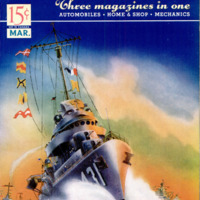 Popular Science Monthly, v. 138, n. 3 1941
Popular Science Monthly, v. 138, n. 3 1941

